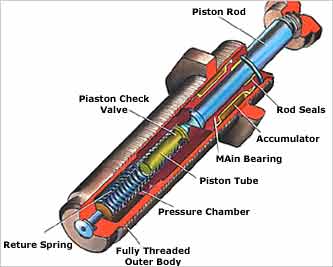| What do shock absorbers do |
|
Essentially, shock absorbers do two things. Apart from controlling
the movement of springs and suspension, shock absorbers also keep your
tyres in contact with the ground at all times. At rest or in motion, the
bottom surface of your tyres is the only part of your vehicle in contact
with the road. Any time that a tyre’s contact with the ground is broken
or reduced, your ability to drive, steer and brake is severely
compromised.
Despite popular belief, shock absorbers do not support the weight of
a vehicle.
|

|
| Types of Shock
Absorber |
|
Although all shock absorbers do the same job, different types of
vehicles and suspension designs require different types of shock
absorbers which can appear radically different.
No matter the application, all shock absorbers fit into one of three
broadly defined types – conventional telescopic shock absorbers, struts
or spring seat shocks
|
| Conventional telescopic
shock absorbers |
| This is the simplest type of shock absorber and is generally
replaced rather than repaired. This type of shock absorber can be found
on both front and rear suspension systems and is relatively inexpensive |
| |
| Strut type shock absorbers |
| Although they do the same basic job, struts replace part of the
suspension system and must be more ruggedly built to cope with greater
loads and forces. Although most commonly seen on the front and rear of
small to medium cars, larger cars are now tending towards strut based
suspension design. The strut category is further divided into sealed and
repairable units. As the name suggests, sealed units are designed to be
fully replaced, whilst repairable (McPherson) struts are able to be
fitted with replacement strut cartridges |
| |
| Spring seat shocks |
| The spring seat type shows characteristics of both telescopic and
strut type shock absorbers. Like struts, a spring seat shock is a
suspension unit and damping device in a single unit. Unlike struts
however, they are not designed to be subject to high side loads. Built
using similar components to conventional shock absorbers, spring seat
shocks are also sealed requiring full replacement. |
|
| |
| Mechanism |
Shock absorber are attached at the end of the piston rod and works
against hydraulic fluid in the pressure tube. The movement of the
suspension up and down force the hydraulic fluid through minute holes
inside the piston. However only small amount of fluid is forced inside
the piston. The insertion of fluid reduce the speed of the piston which
in turn slows down the piston, which in turn slows down spring and
suspension movement.
The speed of the suspension and the number and size of the orifices in
the piston determines the resistance a shock absorber. Nowadays, shock
absorbers are made using this principle. That is faster movement of
suspension means more resistance shock absorber provides. Shock absorber
designed on this basis simply reduces the bounce, Roll or sway and Brake
dive and Acceleration squat. |
| |
| Shock Absorber Working
Principle |
|
There are two cycles in which Shock absorber works: |
| |
| Compression Cycle |
In the compression cycle the piston moves downward and compresses the
hydraulic fluid in the chamber which is situated below the piston. In
this cycle or downward movement, the fluid flows to upper chamber from
down chamber through piston. Some of the fluid also flows into reserve
tube
through the compression valve. Flow is controlled by valves in the
piston and in the compression valve. |
| |
| Extension cycle
|
|
In the extension cycle the piston moves upwards toward the top of the
pressure tube. The upward movement results in the compressing of the
fluid in the chamber lying above the piston. The extension cycle
generally provides more resistance than compression cycle. |
| |
